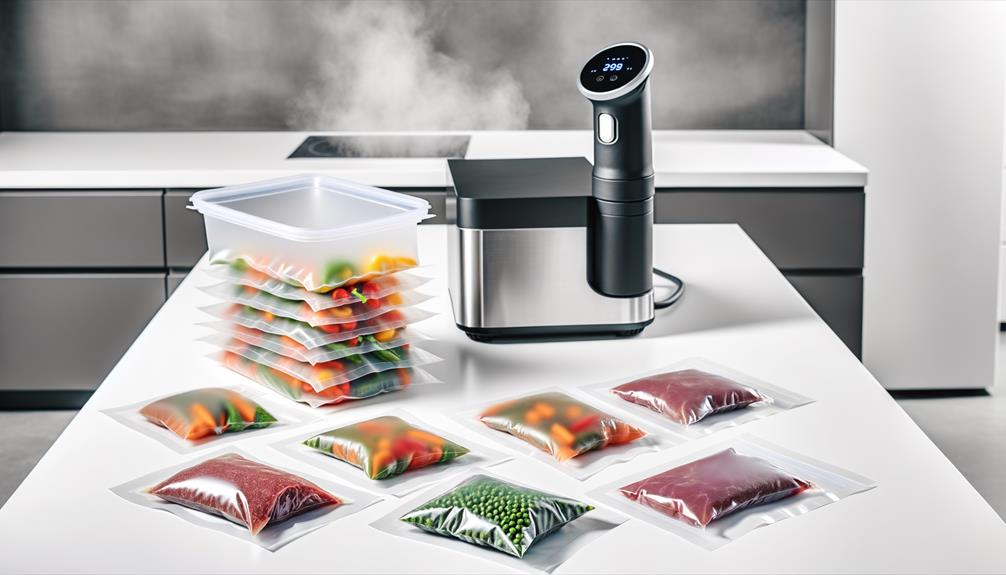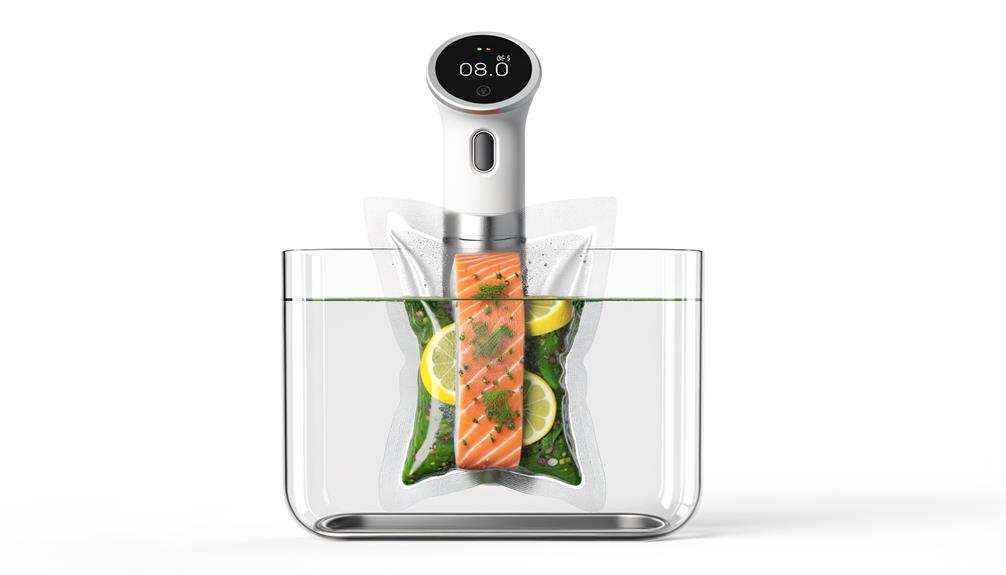Hey there, food lovers! Can't resist the juiciness of a steak made sous vide, right? Don't worry, I've got you covered! This cooking technique is all about precision and patience. Vacuum-seal your favorite protein (steak, chicken, or pork), add some fresh thyme or rosemary, a hint of citrus, and sous vide it to perfection. Want to try rare steak? Set your cooker to around 120°F for 1 to 2 1/2 hours. The results? A tender, flavorful meal every time! And hey, don't stop there, jump into this culinary adventure and see what other wonders you can create!
Sous Vide Cooking Origins
Diving back into the 1970s, we find the roots of sous vide cooking, a method pioneered by French and American chefs that has since revolutionized our kitchen experiences. Quite literally, 'sous vide' translates to 'under vacuum', hinting at the unique preparation process where ingredients are vacuum-sealed before cooking.
Originally, sous vide was a high-tech darling of industrial food production. Its ability to consistently deliver tender, flavorful results won it favor in the culinary world. As popularity grew, sous vide made its grand entrance into home kitchens, changing the way we cook and enjoy food.
Let's not forget the trailblazers of this method, who deserve a hearty thank you. Chefs like Georges Pralus and Bruno Goussault were instrumental in refining and popularizing sous vide. They took a scientific cooking technique and turned it into an art form, enhancing the taste and texture of even the simplest ingredients.
In essence, the origins of sous vide cooking are a blend of culinary innovation, technological application, and a relentless pursuit of perfection. It's a tribute to the lengths we'll go to make our food not just edible, but extraordinary.
Essential Sous Vide Ingredients
When it comes to sous vide cooking, high-quality proteins like steak, chicken, and pork are essential ingredients that form the base of most recipes.
To enhance these proteins, I use fresh aromatics like garlic, thyme, and rosemary. These herbs not only elevate the flavor profile but also fill my kitchen with a delightful aroma that's sure to whet anyone's appetite. I also use butter or oil to add richness and moisture to my dishes. It's a little tip I picked up from a sous vide site, and it works wonders.
Seasonings, too, play an important role. I'm a firm believer in the power of good old salt and pepper, but don't be afraid to experiment with different spices. A dash of paprika or cayenne can really make a dish pop.
Citrus fruits like lemon or orange are my secret weapon. They add a brightness and acidity that beautifully balance out the richness of the proteins.
To give you a quick snapshot, here's a table summarizing my go-to sous vide ingredients:
| Proteins | Aromatics and Fats | Seasonings and Citrus |
|---|---|---|
| Steak | Garlic, Thyme, Butter | Salt, Pepper, Lemon |
| Chicken | Rosemary, Oil | Paprika, Orange |
| Pork | Garlic, Thyme, Butter | Cayenne, Lemon |
Preparing Sous Vide Dishes

Let's get down to the nitty-gritty of preparing sous vide dishes, a process that revolves around precision and patience. Armed with your trusty precision cooker and vacuum sealer, you're ready to delve into the world of sous vide.
Firstly, you'll need to vacuum seal your food. This isn't as intimidating as it sounds, but it does require care. Your vacuum sealer is your best friend here. It guarantees that your food is sealed tight, locking in all the flavors and nutrients.
With your food sealed, it's time for the precision cooker to take charge. This handy device allows you to set the precise temperature needed for your dish and maintains it throughout the cooking process. This ensures even cooking and the perfect level of doneness every time.
When it comes to preparing sous vide dishes:
- Don't rush: Sous vide is all about slow cooking for the best results.
- Quality counts: Fresh, high-quality ingredients will yield the finest dishes.
- Experiment: Feel free to try new recipes and flavors. Sous vide is ideal for culinary creativity.
Expert Tips
As we move on in our sous vide journey, it's time to look at some expert tips.
We'll be discussing how to select the right equipment and how to control your cooking temperature and time effectively.
We'll also share some techniques that'll help you perfect your sous vide cooking skills.
Choosing the Right Equipment
To enhance the site of your kitchen, opt for an insulated container or pot. They help maintain water temperature stability, resulting in perfectly cooked meals every time.
Also, consider a vacuum sealer, it's essential for storing your food properly in sous vide bags, keeping any water from sneaking in during cooking.
Don't forget to choose high-quality, BPA-free sous vide bags designed specifically for this type of cooking- it's critical for food safety.
A device with a wide temperature range and high wattage gives you more control and faster heating times.
Lastly, get a skillet or grill for finishing touches.
Temperature and Time Control
Mastering the art of sous vide cooking lies in knowing the correct temperature and time to achieve ideal doneness for every dish. For instance, when trying out fresh recipes for rare steak, I set my sous vide to 120°F to 128°F and let it cook for 1 to 2 1/2 hours.
For medium-rare steak, I bump up the temperature to 129°F to 134°F and cook it for 1 to 4 hours. I've found that chicken breast turns out juicy and tender at 140°F. Salmon, on the other hand, needs a gentle 122°F for a flaky and moist texture. For pork chops, I stick to 140°F.
I also frequently analyze site usage to find new temperature and time suggestions from other cooking enthusiasts.
Perfecting Sous Vide Techniques
After nailing down the right temperature and timing for my recipes, I've picked up a few expert tips for perfecting sous vide techniques. First, sous vide cooking is all about precision. Using an immersion circulator, I can maintain the exact temperature needed for succulent, perfectly cooked dishes.
Vacuum-sealed bags are key, preserving flavors and preventing moisture loss. For meat dishes, I've found that sous vide shines. It makes for incredibly tender and juicy meats with minimal effort.
Lastly, don't skip the final step: searing or grilling. It adds that irresistible texture and flavor. With these techniques, sous vide cooking has become a breeze, delivering excellent results every time. A bit of patience, the right equipment, and these tips can transform your kitchen adventures.
Final Thoughts
To wrap it up, sous vide recipes truly offer a fantastic variety of dishes, from mouth-watering meats to delectable desserts, all with unrivaled taste and nutritional value. You'd be amazed at what you can whip up with this device. Even cookies can reach a whole new level of delicious with the precision of sous vide cooking.
The beauty of sous vide is its consistency. You're not just wishing for the best when you place your food into the oven. You're ensuring perfect results every time. And it's not just about the meats. You can create indulgent desserts like crème brûlée and cheesecakes that will make your guests think you've secretly enrolled in culinary school.
Sous vide is a game changer in the kitchen. It preserves the nutrients and flavors in food while giving you the ability to produce restaurant-quality meals in your own home. It's a win-win situation. So, if you haven't already, I'd say it's about time you immerse yourself in the sous vide world. Trust me, your taste buds will thank you.
